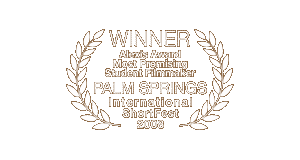PRODUCTION NOTES
First-time writer and director, Susan Cohen wanted to explore the complex relationship that women have with their bodies and what happens when an aspect of what they have defined as part of their femininity and sexuality is suddenly taken away. OPEN YOUR EYES portrays an extremely complicated subject - the effect of breast cancer on a survivor - and there were many challenges. Limited to only fifteen pages of script, per AFI's Directing Workshop for Women (DWW) regulations, Susan wanted to illustrate the impact this disease has not only on the individual but also those closest to them. But, since life as a cancer survivor includes much besides just the disease, Susan also wanted to bring everyday levity to the film. This was accomplished by setting the major arc of the film in a bathroom during a bridal shower - where the lead character, Julia, is "trapped" with a frank-talking stranger, Kat, who has no personal boundaries, forcing Julia, unexpectedly, to open up. To ensure the authenticity of the subject matter Susan worked with The Constance G. Zahorik Breast Center at Huntington Hospital in Pasadena, California. They put Susan in touch with one of their highly regarded breast cancer specialists and surgeon, Dr. Francesca Hoehne, who became a consultant on the project and had the following to say, "This is a great portrayal of 'real issues' ...I think it's so important that this is a film about living, not dying." In addition, a psychologist and breast cancer survivor was instrumental in helping Susan to further shape Julia's story. Susan was also fortunate to have access to women and family members who have been impacted by both breast cancer and other forms of cancer. A key visual element of the story was the contrast between Julia's state of mind and that of her friends as well as the past and present. The filmmakers - David Newsom (Producer), Alisa Wiegers (Producer), Stephanie Martin (Director of Photography), Steven Ansell (Editor), Beauchamp Fontaine Hebb (Production Designer), Darragh Marmorstein (Costume Designer), Heather Howard (Hair and Makeup Artist) and Susan - discussed how best to illustrate this contrast. It was going to be critical to differentiate between the past and present utilizing production design, wardrobe, hair and makeup and camera work. The team work extensively to bring all of the elements together. Also to illustrate past and present, Hair and Makeup Artist Heather mapped out with Susan the various transitions that Julia would go through. Wigs, donated by Reflections part of Simms/Mann UCLA Center for Integrative Oncology, as well as special effects makeup were utilized. Susan and Costume Designer Darragh realized the impact wardrobe would have on the final reveal. Susan wanted it to feel like a blossoming for Julia - after scanning through hundreds of dresses at NBC Universal Costume Department they found the perfect one that would allow for the visual that Susan desired - it need to be both subtle and subconscious to the viewer. Costume design and hair and makeup needed to work in tandem with each other since they would provide the viewer with a timeline that would illustrate the changes that Julia was experiencing both emotionally and physically. One of the elements that became a central theme for Susan when she was developing the script was exterior vs. interior. Susan wanted the exteriors, including the specific lighting and sounds, to be an extra character in each scene, showing that even though Julia has become isolated that life goes on around her, without her. Finding practical locations where elements of greenery were visible from windows was key to building on this idea. Julia and Kevin's kitchen is where this theme was most important - a huge tree outside of the main kitchen window was framed between the two actors during a critical scene. The interior vs. exterior was also utilized during the bridal shower - where at first Julia only wants to escape from the life around her even though she very much wants to be part of it. Director of Photography Stephanie Martin and Susan developed a visual plan to reflect Julia's past and present sense of self. In the film, Julia embarks on a personal voyage depicted using the present and the past. The flashbacks were less color saturated and often had a slight yet subtle cooler hue. The quality of the light in the flashbacks is very soft yet often high in contrast. The characters are often silhouetted in these scenes. There is very little camera movement in these in the past accentuating the feeling of loss and powerlessness experienced by our character. This contrasts with the present which is more color saturated and warmer in tone. Susan and Stephanie were very careful to keep these differences subtle so that the feeling evoked is more subconscious than obvious. Their intention was that the viewer experience the film and draw their own conclusions rather than tell them what they should be feeling or thinking. Since all scenes where shoot at practical, and sometimes confined locations, both Susan and Stephanie had to be creative as possible. They chose to embrace what they at first considered to be limitations and put them to creative use - utilizing mirrors in the bathroom scenes and selective use of depth of field to enhance the point of view of each character. Production Designer Beauchamp also had several challenges and with a limited budget (DWW short films can not exceed a total budget of $25,000), she had to get very creative. There were several locations as well as the affluent bridal shower for Beauchamp to tackle. With the help of Good Gracious event planner Dan Smith the filmmakers were able to pull off a bridal shower that would be the envy of many a bride-to-be. The incredible cast could not have been assembled without the help of Casting Director Monika Mikkelsen. The first to come aboard was Traci Dinwiddie, who combined the vulnerability, strength and anger that was required for the lead role of Julia. Traci has starred along side Rachel McAdams in THE NOTEBOOK and Kevin Costner and Demi Moore in MR. BROOKS. Katherine (Kat) was equally critical, as she had to be a credible counterweight to Julia. Susan wanted someone who could play it straight - the performance needed to be quirky but also understated so that it didn't feel contrived. After reading the script, Suzy Nakamura immediately signed on to the project. Suzy has an extensive list of credits including a recurring role on WEST WING, CURB YOUR ENTHUIASM and HELP ME HELP YOU among others. She will soon be seen in the feature films HARMONY AND ME and DOUBTING THOMAS. For the role of Kevin, Julia's husband, there was never a question once Eric Lange walked into the audition. Eric brought both the passion and vulnerability that was needed for the role of Kevin. Eric effortlessly conveyed the frustration that Kevin was experiencing as he fought to stop Julia from pushing him away. Eric is currently the lead in a new TV series filming in Hawaii. And for the role of Kat's sister and bride-to-be, Teresa Huang's Deborah provided the perfect contrast to Suzy's Kat. Teresa can be seen on the highly acclaimed FX original series THE RICHES in her recurring role as Kimmie. The reveal at the end of the film required extensive CGI so, with casting complete, the filmmakers turned their focus to the visual effects. Unknown to them at the time - that would not be the only scene that would eventually require visual effects. Initially with the assistance of Ken Nakada and then Sean Wilson of The Post Group, the scene was carefully mapped out so that the effect could be accomplished. Traci would need to be tagged with a large mole-like sticker so that the effect could be grounded, preventing it from shifting as she moved and breathed. Next plates had to be shot of an actual mastectomy patient, which would eventually be married to Traci's body. The end result is a seamless and powerful reveal. Unfortunately, during the shoot, the bald cap Traci wore in one scene began to melt off her head - a casualty of shooting in Los Angeles at the height of summer and the heat generated by the lights and equipment in the tight practical location. Willing to take on another challenge, The Post Group was able to repair the bald cap using CGI. What made this reconstruction particularly challenging was that they also had to repair Traci's reflection in a bathroom mirror - compounding the degree of difficulty. All visual effects were completed over a three month period. Another challenge was that the camera malfunctioned on the first day of the shoot, resulting in a significant amount of footage of the bridal shower being lost. Due both to financial constraints and AFI regulations, no reshoots were possible - all DWW shorts are shot over five consecutive days. So Editor Steven Ansell and Susan decided to rethink the opening of the movie as well as how to weave the flashbacks into the story. Steven and Susan had only twenty days to lock picture immediately after production wrapped (per DWW regulations), which was very tricky since Steven was simultaneously editing a feature film for Paramount. Working nights, usually until about two in the morning, they worked together to refine the edit until picture lock. And the challenges continued to appear all the way through the home stretch of post-production. We discovered that the dialogue track (OMF) was not properly translating when exported, and, due to the camera malfunction, the time code on the DAT tapes were not syncing with the time code on the HDCAM tapes. Dialogue and ADR Supervisor Elizabeth Kenton (SUPERMAN RETURNS, THE HUNTING PARTY, THE NOTEBOOK) realized that the only way to fix the sound issue was to manually re-record the DAT tapes onto her system and then hand-cut and place all of the dialogue tracks, which included both production and ADR. Fortunately, Elizabeth's experience and four weeks of hard work resulted in a flawless dialogue track. Once the film was locked Sound Designers Seann Dougherty and Brett Voss began working on the sound design of the film - helping to enhance the exterior vs. interior theme. Susan's vision for the music was that it be understated to the point of minimalism so as not to lead the audience, and Composer Wolfram de Marco created a very beautiful and simple score to support that. The music was confined to beginning and ending of the movie, allowing the performances to speak for themselves and for the audience to react without being led by the music to a particular emotion. Leslie Stevens wrote and recorded the original song that plays over the end credits. The film was completed on April 28, 2008. Due to the collaborative nature of the team and their passion for the story the filmmakers were able to accomplish their goal - to tell a story that they feel addresses the complexity of the issue while still honoring those impacted by cancer..

